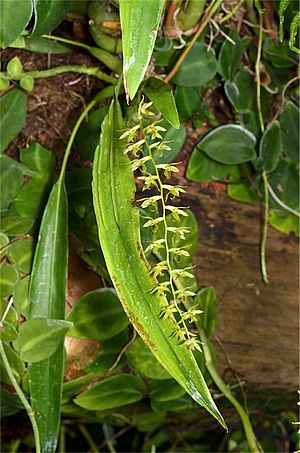Dingy urchin orchid facts for kids
Quick facts for kids Dingy urchin orchid |
|
|---|---|
 |
|
| Bryobium queenslandicum in the Australian National Botanic Gardens | |
| Scientific classification | |
| Genus: |
Bryobium
|
| Species: |
queenslandicum
|
| Synonyms | |
|
Eria queenslandica T.E.Hunt |
|
The dingy urchin orchid, officially called Bryobium queenslandicum, is a special type of orchid. It grows in clumps and can be found only in tropical North Queensland, Australia. This orchid often grows on other plants (called an epiphyte) or on rocks (called a lithophyte). It has thick, green stems called pseudobulbs, and each stem usually has two leaves. When it blooms, it produces small, cream-coloured or pinkish flowers that can even pollinate themselves!
Contents
What Does the Dingy Urchin Orchid Look Like?
The dingy urchin orchid is a herb that grows in thick clumps. It has crowded, cylinder-shaped stems, or pseudobulbs, that are about 40 to 60 millimeters (1.6 to 2.4 inches) long and 8 to 12 millimeters (0.3 to 0.5 inches) wide.
Each of these pseudobulbs has two leaves. These leaves are shaped like a spear or an egg. They are usually 60 to 120 millimeters (2.4 to 4.7 inches) long and 16 to 20 millimeters (0.6 to 0.8 inches) wide.
Its Unique Flowers
When the orchid flowers, it produces a stem that is 20 to 40 millimeters (0.8 to 1.6 inches) long. On this stem, you'll find between three and twelve small flowers. These flowers are cream-coloured or pinkish.
Each flower is about 3 millimeters (0.1 inches) long and wide. They are cup-shaped and feel hairy on the outside. The flowers are also resupinate, which means they are twisted so the lip (or labellum) faces downwards.
- Sepals and Petals: The outer parts of the flower, called sepals and petals, are about 3 millimeters long and 1.5 to 2 millimeters wide.
- Labellum: The special lip of the flower, called the labellum, is about 2 millimeters long and 1.5 millimeters wide. It has three parts, or lobes. The two side lobes stand upright, while the middle lobe points downwards. There are also two small ridges near the base of this middle lobe.
This orchid usually blooms between August and October.
How Was This Orchid Named?
The way plants are named and classified is called taxonomy. The dingy urchin orchid has had a couple of names over the years.
First Discovery and Name
The first time this orchid was officially described was in 1948. A botanist named Trevor Edgar Hunt gave it the name Eria queenslandica. He published his description in a science magazine called The North Queensland Naturalist.
The very first plant specimen used to describe the species, known as the type specimen, was collected by John Henry Wilkie. He found it on Mount Bellenden Ker in Queensland.
Changing Its Name
Later, in 2002, two other botanists, Mark Clements and David Jones, studied the orchid again. They decided to change its name to Bryobium queenslandicum. This new name helps scientists understand its closer relationship to other orchids in the Bryobium group.
Where Does the Dingy Urchin Orchid Live?
The dingy urchin orchid grows in the warm, wet rainforests of tropical North Queensland. You can find it growing on the branches of trees or on rocks. Its natural home stretches between the McIlwraith Range and the Tully River.
Images for kids
-
Bryobium queenslandicum in the Australian National Botanic Gardens


